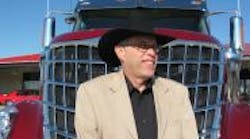“Knowledge is power. Be receptive to learning all you can from as many resources as possible.” –Timothy Brady, business editor, author, consultant, and former owner-operator
It’s ironic, in a way, that many within and outside the trucking industry continue to characterize truckers as “the last of the cowboys,” roaming the roads like the open range of old; independent, self-reliant, content with long periods of isolation.
There’s still a lot of truth to that characterization, of course – it’s still entirely possible to get stuck on the side of the highway with a hatched turbo in the middle of a screaming Wyoming blizzard, with only yourself to figure out a way to get going again. Yet perhaps now more than ever in these tough economic times the inverse is true as well – you need a good network of customers, as well as peers, to survive.
That’s been a key piece of the business advice my compatriot Tim Brady offers: the value of networking. Back when he hauled household goods, for example, he once moved a trailer load of furniture blankets for a customer as a favor. That allowed him to forge a special connection with them; to link them into a network he built over time that he could one day turn to if HE needed a favor, such as a load when times got tough, like they are now.
Brady also never hesitated to put that same practice into effect when it came to interacting with his fellow “bedbuggers” and freight haulers – trading information, advice, and experiences that he could put to good use in his own business.
“Successful truckers have an ear to the road,” he says. “They always have their antennae out for new and innovative cost-savings ideas. They thrive on the input from other truckers, dispatchers, safety and sales people. Keep your eyes and ears peeled for experts, the been-there done-that crowd, for information which will help you become more efficient hauling organization.”
Brady also believes truckers – whether they are drivers, company owners, etc. – should look for information outside the hauling side of the industry and stay on top of the trends and news from your shipper’s perspective.
“Never hesitate to walk in the other man’s shoes,” he says. “One nugget of knowledge received in any of these information pursuits can have the power to raise your success to new heights.”
It’s a theme echoed by Professor Jerry Osteryoung from the college of business at Florida State University. From a broader economic perspective, he thinks increased networking may be the answer for firms in many industries that find themselves struggling.
“A builder came to us with business down by over 60 percent and barely enough money coming in to keep going,” Osteryoung explains. “When the economy was doing great and building was in demand, he had to turn work away and could charge very high prices. However, the world has changed for this builder and for so many others. In contrast, another builder that we are assisting is doing so well that people have to wait three months, even in today’s economy, for him to start on new work.”
What is the difference between these two, you ask? Osteryoung says its networking. “The successful builder belongs to various networking and lead generation groups, and the other does not. The successful builder gets 40 percent of his business through networking, and the builder in trouble has done zero networking.”
While advertising is effective, Osteryoung believes networking and referrals are so much better.
“If a friend says to me that they just tried a product and loved it, I am going to try it,” he explains. “Networking is not just meeting folks. Rather, networking is about getting to know and trust people. Trust takes a long time to develop, but once it is there, it is as solid as granite.”
Networking should be thought of as a way of developing trusting relationships, he notes. “When you go to a function, rather than meeting as many people as you can, try to get to know three or four people in depth that you would like to have a continual relationship with,” Osteryoung says.
And he stresses that it is not just joining the group that increases the power of networking; rather, getting involved is the real heart of the networking process. “Networking in a community organization involves both joining and more importantly, giving something of yourself,” Osteryoung points out. “This is what allows trust to be shown and developed.”
Good advice for getting through the tough times we’re in.





